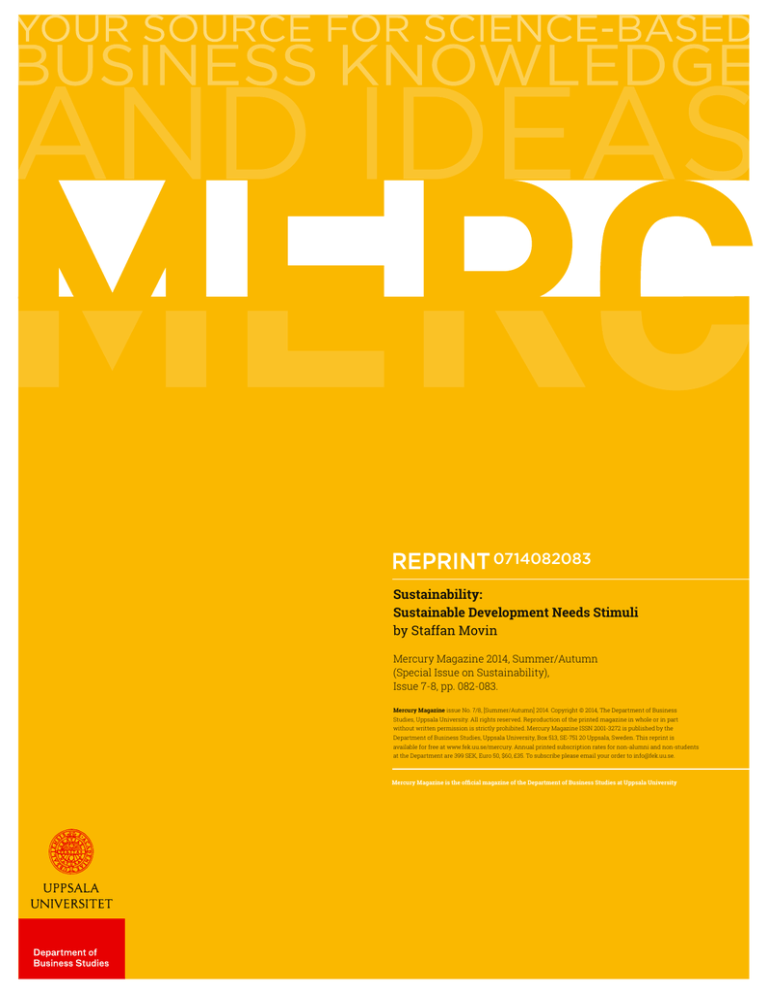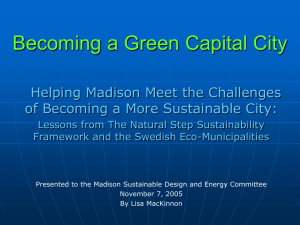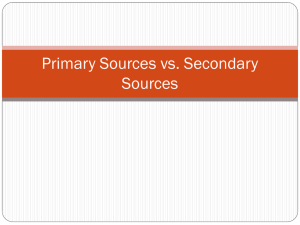
0714082083
Sustainability:
Sustainable Development Needs Stimuli
by Staffan Movin
Mercury Magazine 2014, Summer/Autumn
(Special Issue on Sustainability),
Issue 7-8, pp. 082-083.
Mercury Magazine issue No. 7/8, [Summer/Autumn] 2014. Copyright © 2014, The Department of Business
Studies, Uppsala University. All rights reserved. Reproduction of the printed magazine in whole or in part
without written permission is strictly prohibited. Mercury Magazine ISSN 2001-3272 is published by the
Department of Business Studies, Uppsala University, Box 513, SE-751 20 Uppsala, Sweden. This reprint is
available for free at www.fek.uu.se/mercury. Annual printed subscription rates for non-alumni and non-students
at the Department are 399 SEK, Euro 50, $60, £35. To subscribe please email your order to info@fek.uu.se.
Mercury Magazine is the official magazine of the Department of Business Studies at Uppsala University
As Gro Harlem Brundtland stated in ”Report of the World
Commission on Environment and Development: Our Common
Future” from 1987; sustainable development means meeting
the needs of today through development that won’t cripple us
tomorrow. The significance of the report’s message was that it
stated the importance of environmental responsibility alongside
with businesses, as well as society’s, need for growth. Today,
more then 25 years after the report, we still need to become
better at putting sustainable development into practice.
A way to do this is to emphasize the “pull mechanisms” that
provide stimulation to sustainable development. Examples of
these mechanisms are customer values/behavior, regulations,
It’s not a tall order, argues Staffan Movin,
who calls for cooperation between
society, academia and business.
Staffan Movin is the Managing Director of the
Marketing Technology Centre Foundation (MTC)
which promotes value creating interaction
between business and research. He is Mercury’s
columnist on knowledge transfer between
academia and business.
direct investments and public/private
partnerships. These areas need to be
focused upon in governance, in business, as well as in research.
SUSTAINABILITY
The role of customers
Customers are one of the most powerful “pull mechanisms”
once you get them involved. In the late 80’s, coffee filters
where in focus of environmental attention. Customers could
not understand the need for bleached filters as the bleaching
hade no affect on the products performance what so ever. In
just a few months, the market shares for coffee filters shifted
significantly, changing the market structure and unbleached
filters became standard. This also changed who dominated the
market. Even if changes in environmental behavior are not that
sudden anymore, corporations must take a responsibility and
start acting environmentally fair. Understanding customers
and customer values are probably more important today in
order to sustain an attractiveness of corporate offerings.
Customers are also important players in establishing an
opinion that regulators have to adapt to. This has increased
norms and regulations in most industries, often with
perspectives that are aimed to gain a sustainable environment.
Unfortunately many decisions as well as traditional lobbying
082
have often used environmental arguments in order to preserve
the industry’s domain, instead of opening up to sustainable
development through stimulating cross-industry solutions.
The focus has too seldom been on deregulation. Therefore both
the industry and research should work to identify regulations
and norms that are harnessing the possibility of development
that is or might be essential for sustainability.
Sustainability – strategic potential
Throughout the years, the environmental perspective has
grown in importance both due to customers and through
societal interventions. This development will most certainly
continue and could easily be used as prerequisites and
framework for business strategies. If implemented
properly, it should also provide a comparative advantage.
But it is important to address sustainability in a strategic
perspective instead of something the business “just should
adapt to”. In the 90’s, I was on a sustainable business
conference with senior executives from Swedish, German
and Japanese car-manufacturers. Both Swedish and
German executives stressed how much they focused on
sustainable business. In contrast, the Toyota executive said
they had no strategic possibility to provide an impact on
sustainable issues for five more years. Today, few can argue
that Toyotas strategic inclusive perspective has not had
more effect than their competitors.
Today Swedish companies can benefit from Sweden’s
high level of knowledge and awareness in sustainable
issues. There are interests from large international
companies to place research-centers in Sweden, as
they believe the centers can be stimulated by Swedish
companies and research. If we can support these interests,
then future direct investments will support and become
stimuli for sustainable innovations.
artw o rk b y A ndreas S chrader
/ Both Swedish and
German executives
stressed how much they
focused on sustainable
business. In contrast, the
Toyota executive said
they had no strategic
possibility to provide an
impact on sustainable
issues for five more years.
Today, few can argue
that Toyotas strategic
inclusive perspective has
not had more effect than
their competitors. /
What can make it happen?
There is a need to work proactively to stimulate sustainable
development. Seed-money to companies or innovations will not
make a great difference. Instead, government and governmental
agencies must use interventions that are timed right. For
example, the EU made a call some years ago concerning Green
Buildings. This intervention was well timed with market
demand. NCC, who participated in the program could thereby
also benefit from taking a market leading position.
Perspectives that can provide the needed pull and increase
the pace of innovation are public/private partnerships
and innovation procurement. The latter is described as
transformative procurement in the official investigation
published last year (Upphandlingsutredningen — SOU 2013:12
Goda affärer: en strategi för hållbar offentlig upphandling).
Society can, in other words, become a leader and take the
role as an important pull mechanism to make sustainable
innovations happen.
We must reflect that it is more than 25 years ago Brundtland
published her report and we are still struggling on how to
combine the development and societal responsibility. I believe
we can act in a different way, to better stimulate innovation and
change. What is required is the cooperation between society,
academia and business.
083










